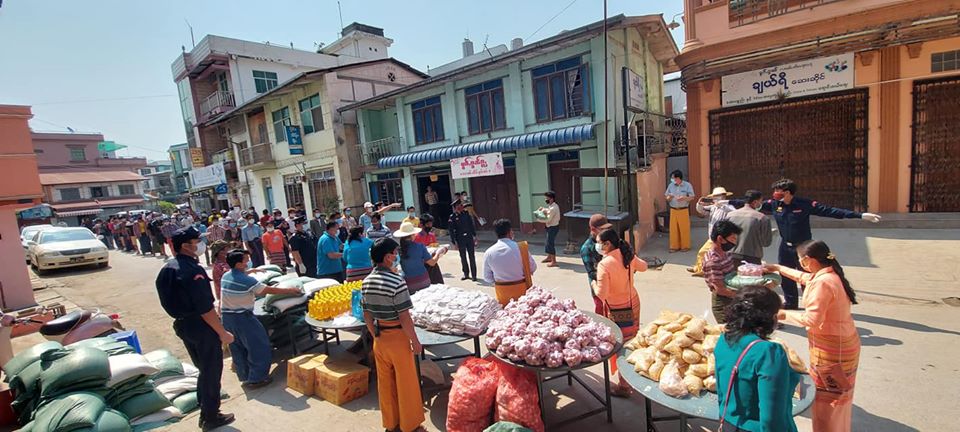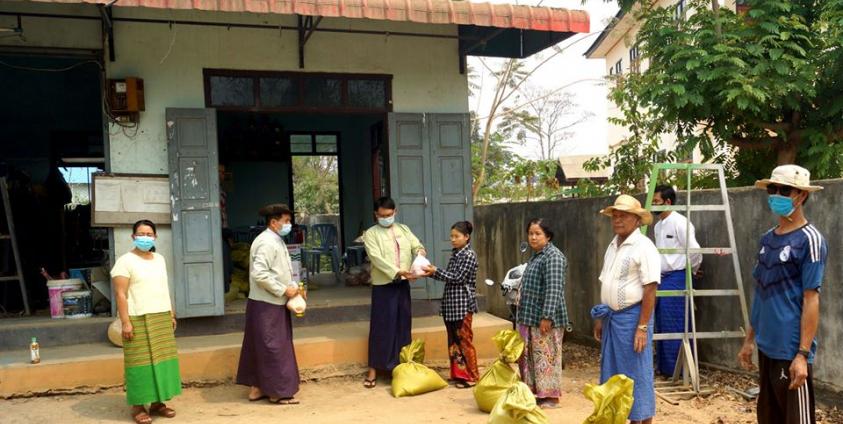To control the spread of COVID-19 in Burma, the government issued stay-at-home orders during the Thingyan water festival in mid-April and announced provisions of food assistance to more than 100,000 families across Shan State.
While the government has lauded its own efforts, the assistance—doled out nationwide—amounted to less than US$15 (20,000 kyat) worth of food for each family: rice, cooking oil, salt, and beans. It was designated for the “working class,” which the government said included daily wage workers, trishaw drivers, brick layers, carpenters, fishermen, boat operators, and farmers.
Locals have criticized the handouts for being insufficient, unfairly distributed, and the aid process as lacking transparency.
“Working class people in villages did not get this assistance. Only people in towns got it. Some of the people who have regular income and who live in downtown areas still got the assistance,” Sai Harn, who is working with the Northern Shan State COVID-19 Prevention Volunteer Team, told SHAN.
Sai Harn said that those who had means to do so traveled to the northern Shan State city of Lashio by car or motorbike to collect the food packages, because they were not distributed in remote communities.
“People living in Mong Yaw and Nam Pao areas, which are located far from the town, have not gotten any assistance,” he explained.
Not even all those in towns who would have qualified for the assistance received it, others said, citing discrepancies between their official household registration documents and their actual places of residence.
“The government distributed the assistance according to the family registration list. Some people are poor, but their family registration is listed in a different ward [than where they were living], so they couldn’t get the assistance even though they are living in poverty,” Nang Mwe Leun, who lives in Hsipaw town in northern Shan State, told SHAN.
Discrepancies with registration, eligibility
According to Nang Mwe Leun, respective local officials and village headmen made the lists of people in need and then distributed the food aid.
“They had to make the lists. They knew who the poorest people were. The problem was that those people didn’t have a family registration list for that ward, so they didn’t get any assistance,” she said.
Nang Kham Lao Leun, who lives in Langkhur town in southern Shan State, was among those who did not receive any food assistance, even though she says she should have qualified for it. Yet what is being given is not enough to feed a typical household for a week, she said.

“If a family has five people, the assistance is not enough for them,” she told SHAN.
She reported similar discrepancies to those in the northern part of the state regarding distribution, including a lack of food given out in rural villages in Mongpan and Langkhur townships, and most of the aid going to those in towns.
“According to the government’s announcement, if a family receives support from abroad, the government wasn’t going to give assistance to that family. But some families got assistance even though these families have support from abroad,” she said, adding, “many Shan people haven’t gotten assistance.”
Part of the blame is on local authorities for not standing up to government officials, villagers said, adding that information about the aid process was not shared with residents and those in need.
“There was no transparency. Village headmen didn’t show who was on the list, so people in villages didn’t get assistance even though they should have gotten it,” Ko Sai who is working with the Hsipaw COVID-19 Prevention Volunteer Team, told SHAN.
He urged members of the Burmese government to witness firsthand the challenges faced by villagers who continue to struggle to get food while being out of work due to the COVID-19 pandemic, who had expected to receive support.
“We want the government to observe the situation on the ground and see whether their assistance is effective for the people,” Ko Sai said.
‘No problems’
A member of the COVID-19 prevention team in the town of Hsi Hseng, in southern Shan State, reported no problems with the distribution of the food aid. He described the same process as those in Hsipaw and Langkhur but reported that it had worked.
“Only poor people and working class people got the assistance. The respective officials and village headmen checked the list of these people. Here in Hsi Hseng, we didn’t have any problems with the distribution of the assistance,” volunteer San Win Maung told SHAN.
He added that even though the food packages had provided short-term relief in Hsi Hseng, the long-term issue of insecurity had not been addressed.
Shan State government representatives also praised their food handout program.
“I think the distribution of the government assistance during the water festival period was the most successful. We didn’t have any problems,” planning and finance minister Soe Nyunt Lwin said. “Now that the Thingyan period is over, we have a plan to provide assistance after Thingyan.”
The state’s finance minister did not elaborate on what the plan entailed or how it would be implemented.
Locals say that the longer people are out of work—and live in an economic system in which the ability to meet their basic needs depends on their ability to work—the aid that they require will continue to grow.
“The working class people will have more difficulties. They will struggle for food. We want the respective officials to consider them,” Muse resident Sai Hla Maung told SHAN.
Across the state, locals have called on the government to draw up a concrete plan in which assistance can be distributed consistently and fairly to all those in need.
“We don’t know how long this pandemic will go on. We are all struggling for food during the outbreak of this pandemic,” San Win Maung in Hsi Hseng said. “People will have to struggle as long as this pandemic is here. I think people in villages will have a lot of troubles if this situation goes on longer.”
As of April 27, the Ministry of Health and Sports reported that the country had 146 confirmed coronavirus infections, five deaths and 10 recoveries.
In Shan State six people have tested positive for COVID-19.







